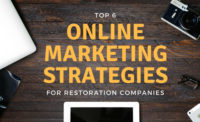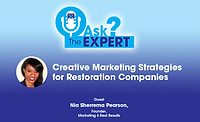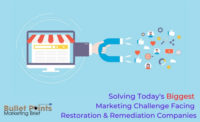Marketing is an ongoing effort. This concept is easily understood when you start your business. When your business stops marketing, it starts dying. The problem is, many restoration businesses attempt marketing and fail and become hesitant to try again.
I’m going to let you in on a little marketing secret. If you are building a business, you need to take massive action. Don’t attempt one marketing strategy and give up. Execute three marketing strategies at once and refine each one until you have a winner. When you get a winner, keep testing other strategies until you find another winner. If you want to gain top market share and keep it, you have to constantly out-market your competition.
Over the last eight years of consulting with cleaning and restoration companies, here are what I’ve found to be the top six most successful marketing tactics.
1. Referral Program
Referrals are the lifeblood of any restoration business. Investing time and money on a solid referral program will benefit you many times over. Your program should be in a clear, written statement of what you do when you get referrals. You might give $100 cash for any water loss referral. Or some companies give 10% off the entire paid invoice as a referral commission. Whatever you decide, make a written plan and stick to it.
From there, target businesses in a position to refer you – like insurance agents or suppliers. Visit them every few weeks, with food in hand. When you walk in with donuts, cookies, or candy, you’re a welcome guest. Before or after visiting, send them a letter or postcard that tells how you can help their clients. Show them how you can be their hero.
2. Brochure Sales System
This is a marketing tactic often overlooked in our industry. Brochures should be purposefully created to educate clients. When someone calls you for a restoration job, they are often confused and overwhelmed. Even worse, they don’t have a clue about what you’re going to do for them. This is your chance to win through education. Your brochure may include things like how to avoid mold growth, what to do after a flood, or how to communicate with an adjuster.
After a hurricane hit my area, I walked into a ravaged home. After handing the homeowner a brochure on what to do after a flood, she hugged me and cried. She thanked me for helping her before I even started working.
A good, educational brochure helps you get seen as a true professional. Brochures are also great sales tools when you’re talking with plumbers, realtors, and other businesses about your service. They show how you can help them and their clients. Give your referral sources stacks of your brochures with a brochure holder so they can set them out for their clients to take.
Educate your prospects and you’ll win them over for life.
3. Client and Prospect Newsletters
All your referral sources and past clients should be receiving regular education from you. This should be done in the form of a physically mailed newsletter or postcard. Additionally, you should be sending email newsletters to anyone who has given you their permission. Do both! Keep in mind, however, not everyone wants to receive email from you. The only sure way to reach your clients and prospects is by mail.
Send newsletters at least quarterly. When your referral sources see how you consistently educate them, you’ll be looked upon as a reputable professional. As a huge side benefit, you’ll also be staying at top of mind awareness for the people in your city who are in prime position to refer you.
4. Search Engine Marketing
Getting ranked on the first page of Google will bring you business. The problem is, there are lots of myths floating around about how to get ranked on Google. Even worse, telemarketers call almost every day with a miracle answer.
My first piece of advice is to never give money to a telemarketer selling SEO services. Anyone good at SEO doesn’t have time to telemarket you. They’re too busy and they don’t do it for a miraculous $200 per month.
Here are some tips to help your rankings. First, make sure you fill out a Google+ Business Profile at www.google.com/mybusiness. Then, work on getting as many reviews as possible. These reviews help to prove to Google that you’re a real company. Second, make sure your website is not overusing keywords. For example, having “water damage” written repeatedly on your page will hurt your ranking for water damage. Your website text should be well-written and read naturally. Lastly, concentrate on getting relevant links to your website and avoid irrelevant links. Get links mostly from other local websites and industry-related web pages.
5. Social Media Marketing
Your clients and prospects use social media, so you should too. Connect with your referral sources via Facebook and LinkedIn. But don’t forget Twitter, Instagram, Pinterest, Tumblr, and others. The main goal is to interact and educate. Join local Facebook and LinkedIn groups about home maintenance and restoration. One thing I like to do is post an educational article on my website’s blog. Then, when the subject comes up in one of those social media groups, I give a link to my blog article. This pulls traffic to my site and also helps my ranking.
If you don’t do anything else with social media, at least keep an updated Facebook business page. Consumers actively search businesses on Facebook to find more information. Consider doing a Facebook ad campaign to get your posts seen when needed. The Facebook ad campaigns can be done for as little as ten cents per click. Again, social media is your opportunity to educate clients and prospects.
6. “Ready” Marketing
Get a plan ready for your flood season. My cleaning and restoration business is in Florida where we get hurricanes and heavy rains certain times of the year. When this time of year is approaching, we keep a marketing plan ready to execute specifically for this period. We get brochures printed up on what to do after a hurricane. Facebook campaigns are also designed to be posted the day before the threat of a hurricane or huge rain in order to educate on what to do. Neighborhood flyers are prepared to be distributed in neighborhoods with the worst losses. Colleagues from out of town are called and put on notice in case we need to sub out some of the work. Everything is pre-set and ready to go so we’re not fumbling around after the emergency hits. The goal is to be ready to get business done!
As an honorable mention, I’ll include the yellow pages. I know it’s an old dinosaur, but some companies in smaller cities still do well with it. If you’re in a small city or a city with a large segment of the population over 45 years old, you may consider advertising in it.
These are tactics I’ve used and have seen other restoration companies use to grow successful businesses. Pick a few and keep working at it to get your restoration business the clients you need for success.






Report Abusive Comment